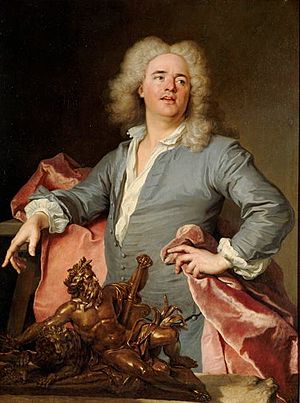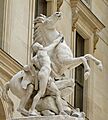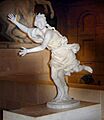Guillaume Coustou the Elder facts for kids
Quick facts for kids
Guillaume Coustou the Elder
|
|
|---|---|

'Guillaume Coustou the Elder by Jacques-François Delyen, in the Palace of Versailles, Salle Louis XIV
|
|
| Born | 29 November 1677 |
| Died | 22 February 1746 |
| Nationality | French |
| Known for | Sculpture |
| Movement | Baroque and Style Louis XIV |
Guillaume Coustou the Elder (born November 29, 1677, in Lyon; died February 22, 1746, in Paris) was a famous French sculptor. He created beautiful art in the Baroque and Style Louis XIV styles. He was a special sculptor for King Louis XIV and King Louis XV. In 1735, he became the Director of the Royal Academy of Painting and Sculpture. He is most famous for his giant horse statues, originally made for the Chateau of Marly. Copies of these horses are now in the Place de la Concorde in Paris.
Contents
Life of a Sculptor
Guillaume Coustou came from a family of talented sculptors. His uncle, Antoine Coysevox, was a royal sculptor, and his older brother, Nicolas Coustou, was also a well-known artist. Even his son, Guillaume Coustou the Younger, became a famous royal sculptor!
Like his brother, Guillaume won the Prix de Rome. This was a special award from the Royal Academy that allowed him to study art in Rome for four years. However, Guillaume decided to leave his studies early. He wanted to create his own path as an artist. For a while, he worked in the studio of the painter Pierre Legros before returning to Paris.
Creating the Marly Horses
When he came back to Paris, Guillaume helped his uncle Coysevox create two large horse statues. These were called Fame and Mercury. They were made for the Château de Marly, a new home for King Louis XIV near the Palace of Versailles. The King went to Marly to relax away from the busy palace.
Later, between 1740 and 1745, Guillaume Coustou made his own famous horse statues. These were called The Horses of Marly. They were created to replace the earlier ones. These horses were inspired by ancient Roman statues of horse tamers. King Louis XV ordered them in 1739, and they were placed at Marly in 1745. People thought these horses were masterpieces, showing the grace and feeling of the French Late Baroque style.
After the French Revolution, the horses were moved from Marly to the start of the Champs-Élysées in Paris, at the Place de la Concorde. To protect the original statues, they were moved indoors to the Louvre Museum in 1984.
Joining the Royal Academy
In 1704, Coustou was accepted into the Académie royale de peinture et de sculpture. For his entry, he created a sculpture called Hercules on the Pyre, which is now in the Louvre Museum. This artwork shows off the Baroque style with its twisting and rising shape, and amazing carving skills. He continued to rise in the Academy and became its Director in 1733.
Other Important Works
Another important sculpture from his later career is the statue of Queen Maria Leszczynska, made in 1731, which you can also see at the Louvre.
Coustou also made two giant sculptures for the park at Marly, called The Ocean and The Mediterranean. He created the bronze statue of the Rhone river, which was part of a statue of Louis XIV in Lyon. He also made sculptures for the entrance of the Hôtel des Invalides in Paris. One of these, a bas-relief showing Louis XIV on horseback, was destroyed during the French Revolution. However, it was restored later using Coustou's original design. The bronze figures of Mars (the god of war) and Minerva (the goddess of wisdom), made between 1733 and 1734, are still there on either side of the doorway.
In 1714, he worked with his brother Nicolas Coustou on two marble sculptures for Marly. These showed Apollo Chasing Daphne. Nicolas sculpted Apollo, and Guillaume sculpted Daphne. Around the same time, Guillaume was asked to create another running figure in marble, a Hippomenes. This was made to go with an Atalanta statue copied from an ancient artwork by Pierre Lepautre. Both statues were placed in the middle of the carp ponds at Marly.
In 1725, a duke named d'Antin ordered two life-size marble statues. These showed King Louis XV as the god Jupiter and Queen Marie Leszczynska as the goddess Juno. They were made for the park of his château, which was next to Versailles.
Many of his sculptures were made for the Tuileries Gardens in Paris. These include a bronze Diane à la biche ("Diana and a Deer") and Hippoméne (1714). The Hippoméne was first at Marly, then moved to the Tuileries, and finally to the Louvre Museum in 1940.
Coustou's marble Bust of Samuel Bernard is at the Metropolitan Museum of Art in New York. Guillaume often worked with his brother Nicolas Coustou, especially on decorating royal buildings at Versailles.
Images for kids
See also
 In Spanish: Guillaume Coustou para niños
In Spanish: Guillaume Coustou para niños








